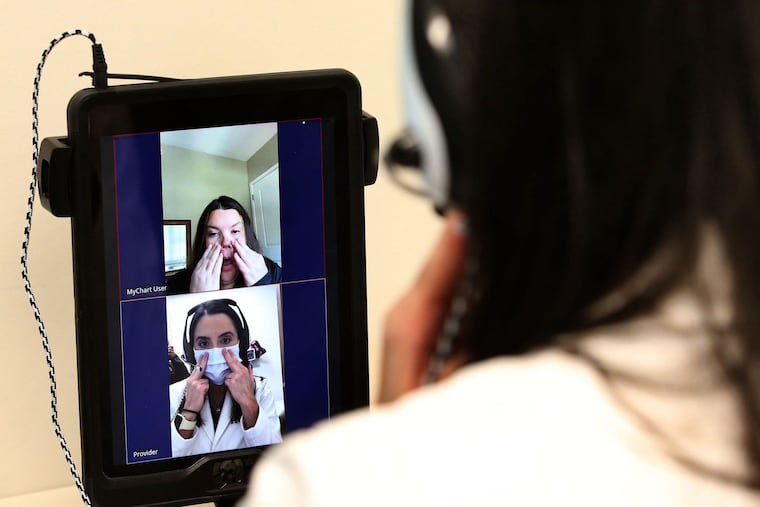Doctors offer advice for how to prepare for your telehealth visit | Expert Opinion
If you are trying telehealth out for the first time, or looking for a smoother experience than your last visit, here are tips to help you get the most out of your visit.

Telehealth has become ubiquitous due to the current pandemic. We recognize why: Your doctor’s office may be closed, you can’t get an appointment for weeks, or you simply don’t want to be seen in person due to the risk of exposure to COVID-19 and other contagious diseases.
Telehealth has become the solution for timely and convenient care to patients without any geographic limitations. Although telehealth is not for everything, it is a great option for certain questions, symptoms, or even prescription refills. If you are trying it out for the first time, or looking for a smoother experience than your last telehealth visit, here are tips to help you get the most out of your visit:
1. Determine the type of health-care visit you need
Is this an emergency, an urgency or a scheduled primary-care visit? Each medical encounter has a different purpose. Help with your chronic medical diagnosis and visit with primary-care doctor or a specialist needs to be scheduled for a designated day and time. If you have an acute issue (a sudden onset of symptoms), call telehealth, where you will likely meet one of our group: emergency physicians.
2. Make your appointment call in the right physical spot
Remember that during a telehealth visit you will be speaking about sensitive information. Select a confidential, secure spot to avoid noise interference, and other people overhearing your sensitive health information. Consider this if calling from your office, and outside in public spaces.
Do not call while driving! Just as texting and driving is dangerous, calling for a telehealth visit while driving is very dangerous. A responsible clinician will ask you to pull over before continuing the visit. We even advise this if you are a passenger. Your private medical information will be heard by other passengers and the reception and connectivity may be poor if you are moving. The clinician cannot conduct a virtual physical examination with you sitting in your car.
3. Check your technology
As you would for a virtual meeting on Zoom, check your lighting, WiFi connection and audio/video. A functional space means the difference between a successful telehealth visit and one that is suboptimal and even fails. Your provider may ask you to download an app to complete the visit, please do that ahead of time. Most connectivity issues are solved by rebooting your phone or laptop. Consider a practice call, if possible, especially if it’s your first time.
4. Prepare your medical history
Do you know your medications? Take a picture of the bottles or make a list. Have your medical history ready to share. If your concern is something you can show the telehealth clinician, then take a picture. An animal bite, a swollen ankle, or a sore throat are common examples. Telehealth apps allow you to upload images before you connect with your clinician. Is your pharmacy information correct? Enter that into the information portal. Close attention to these items solves many issues and ensures a smoother visit.
5. Prepare to be examined
During your visit, the clinician may involve you in the physical examination. Call from an open space where you are comfortable, and where you can be mobile. Become acquainted with your phone or laptop so you can move the camera, allowing the clinician to see. If you have a thermometer, a watch/timer or a pulse oximeter, record your vital signs ahead of the call. Share your temperature, your heart rate, your respiratory rate, and your blood pressure and oxygen if available. Have a flashlight ready in case we need to examine your throat, or your eyes. If a trusted partner, family member, or friend is with you, that person can be your assistant.
6. Prepare your questions
Be mindful that when you first connect, the clinician must confirm your name and date of birth. After that, don’t be afraid to describe why you are calling and what your concern is. We can help more effectively if you share your worry with us. Make sure we answer all your questions. Before you log off, be sure you understand your clinician’s explanation of the medical condition, what you need to do, and what you should keep an eye on.
7. Keep your expectations open
Sometimes we will recommend a higher level of care. This means that we may advise you to be seen in person right then. We understand that this may not be convenient and may take you by surprise. You thought telehealth could take care of everything. Unfortunately, it cannot. You are our focus. Your safety is our priority, our goal, and our responsibility.
Aditi U. Joshi is the medical director of JeffConnect Telehealth and an assistant professor of emergency medicine at Thomas Jefferson University. Resa E. Lewiss is the director of the Point-of-Care Ultrasound Division and a professor of emergency medicine and radiology at Thomas Jefferson University.